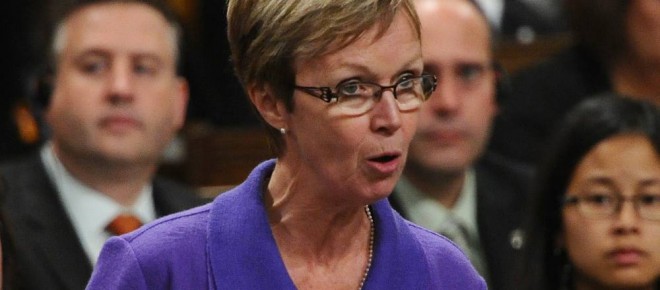The Commons: The F-35 has as many explanations as problems
The latest twist involves the small matter of whether or not the expensive aircraft will be useless
Share
 The Scene. “The F-35 saga continues,” Nycole Turmel declared by way of opening.
The Scene. “The F-35 saga continues,” Nycole Turmel declared by way of opening.
The latest twist in this epic tale of stealth flight involves the small matter of whether or not the expensive aircraft will be more or less useless when patrolling our vast northern frontier. “We learned today that the aircraft will be delivered to Canada without adaptive equipment to allow communication in the Arctic. It’s really something,” the interim NDP leader exclaimed for the benefit of those who like their parliamentary invective relayed in the most folksy manner possible.
Peter Van Loan, the government House leader, duly stood here to wrap himself in the flag and throw himself around the troops. “We are proposing to deliver to Canadian Forces the resources and equipment it needs to be able to protect Canadian sovereignty and security and to ensure that our defences are strong,” he explained. “The F-35 will have all the capabilities that are necessary to do so, including that primary critically important mission of ensuring our northern sovereignty is protected.”
This did little to assuage Ms. Turmel, who returned to her feet with a list of concerns.
“Mr. Speaker, at what costs? This is incredible,” she surmised. “The F-35s Canada is buying cannot be refuelled mid-air with existing air force equipment and they cannot land on short runways in Canada’s North. Now, we learn that our brave pilots will not be able to communicate while patrolling our Arctic airspace. Can members believe this?”
Mr. Van Loan summarily ruled all of this out of order. “Mr. Speaker, the leader of the opposition asked if I can believe that and the answer is ‘no,’ ” he said. “I cannot believe a single thing she said in that question because those statements are false.”
It is, of course, only on the government’s own terms that these northern circumstances are of much concern. If this debate wasn’t based on the premise that the nation needs 65 state-of-the-art fighter jets for the primary purpose of warding off a Russian invasion, this issue with the radio reception might be of secondary interest. If, for instance, the government had simply outlined a desire to drop bombs on things in foreign countries—or “spread freedom” or whatever the proper wording is these days—we wouldn’t now be faced with a national debate based on the plot of Red Dawn. (Granted, that might’ve initiated an altogether more complicated debate about the future of international intervention and military action, but at least it would’ve been somewhat less imaginary.)
None of which is to say that NDP’s Matthew Kellaway wouldn’t have been on his feet anyway this afternoon with a sort of omnibus complaint. “Mr. Speaker, the list of flaws with the F-35 is a long one,” he said. “It includes: bulkhead cracks, airflow problems, poor parts reliability, wing roll-off issues, drive shaft stretching and compressing, actuators burning too fast, defective lift fan clutch, generator problems.”
None of which should matter if Mr. Kellaway properly and truly supported the troops. “Mr. Speaker,” sighed Defence Minister Peter MacKay, “it is a stretch of credibility that the member opposite and his party, on every occasion, take every chance they can to try to denigrate the efforts of this government to invest in the Canadian Forces.”
To complicate matters all the more, here came Bob Rae, playing the part of the wise and reasonable elder. “I would say in praise of the Minister of National Defence, the process he ran on shipbuilding was a tremendous process,” he offered. “Why not do the same thing for the F-35s?”
Mr. Van Loan was not about to fall for this and instead ventured, as the government periodically does, that the purchase of the F-35s was preordained by a decision made many years ago by a Liberal administration. Already disputed by current Liberals, this line of argument also now seems to run in contradiction to something the Prime Minister said last week about something else entirely. “Mr. Speaker, the law of our constitutional system is extremely clear,” Mr. Harper asserted last Wednesday. “A previous government cannot bind a future government to its policy.”
Whether or not any kind of agreement exists, whether or not it is in any way binding, there is always some other argument to be made. Indeed, having asserted national sovereignty, having pledged support for the troops and having blamed the previous government, the Conservative side played its trump card: the unendingly fragile economy and the soothing prospect of job creation. “We are going to have jobs created in those areas in the state of the art aerospace industry,” Mr. Van Loan sang. “That is something that the member would have us put to a halt, to kill those jobs. We will not kill those jobs. We want to see jobs and growth for all Canadians.”
All Canadians will no doubt be thankful for the jobs. And hopefully some of those jobs will involve building proper radios. For gainful employment will be of little concern if we are all living under Soviet rule.
The Stats. The F-35s, seven questions. The military, six questions. Shipbuilding and Libya, three questions. The environment, trade, seniors and the G8 Legacy Fund, two questions each. Turkey, the Canadian Wheat Board, foreign investment, salmon, the economy, the long-gun registry, Egypt, aboriginal affairs, the Air and Space Museum, Pakistan, bank fees and firefighters, one question each.
Peter MacKay, eight answers. Peter Van Loan, six answers. Deepak Obhrai, five answers. Jim Flaherty, four answers. Rona Ambrose, three answers. Gerry Ritz, Gerald Keddy, Joe Oliver and Vic Toews, two answers each. Keith Ashfield, Jason Kenney, John Duncan, James Moore and Bev Oda, one answer each.